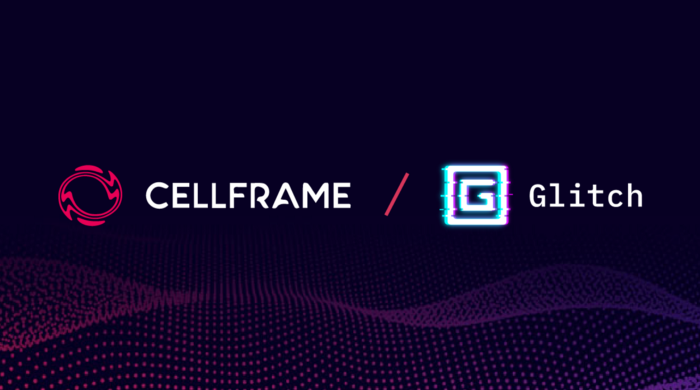Cellframe Partners with Glitch
Category: Announce

We are pleased to announce a partnership with Glitch, a blockchain-agnostic super protocol designed specifically for trustless money markets. Together we will be expanding the horizons of both projects via token wrapping, order book sharing, and collaboration around post-quantum encryption.
Building a decentralized bridge between Cellframe and GLITCH
The first goal is to wrap Cellframe’s native CELL tokens into the GRC20 standard. The result will be a set of computers, where every computer has node software for both Glitch and Cellframe. Such a solution is referred to as a ‘bridge node.’
Every bridge node will be able to pass states from GLITCH to Cellframe, enable selection by pseudo-random function, and receive a transaction as input. If a node sees that it’s selected to pass the state via atomic swaps, it’s tracking for locked tokens in one network and create/burn the same amount of coin in a bridged network. Other nodes validate it, a few of them sign it as well.
All bridge nodes have a stake, and if anything goes wrong, they will lose all or a portion of it. And in order to wrap GRC20 tokens back into the Cellframe Network, the same process is carried out in reverse via a special smart contract to be created on GLITCH.
Connecting the GEX and Cellframe DEX order books
Another primary aim of the partnership will be to sync order books between our respective DEXs. To start, there is the Cellframe DEX t-dApp service with an order book shared via Cellframe. Cellframe Core Network will be used as a token hub, and after bridging the networks, it will be possible to share order books so that traders on the Cellframe DEX will be able to see Glitch orders for wrapped tokens and vice versa.
Expanding transaction type functionality for wallets
Cellframe features multi-signatures and has an added ability to mix different signature types into one multi-signature. This technology will be shared along with the Cellframe crypto library, thereby enabling the multi-sig ability in both networks. Conditioned transaction technology could also be ported over to extend additional Glitch functions.
Exploring quantum-resistant signatures
Cellframe has a library with many algorithms that can be implemented into Glitch. These algorithms have the potential to raise Glitch’s overall level of security significantly. The options include IAES, an improved AES version with additional quantum-proof features. OpenAES implementation, a faster version of AES but one that is not quantum-proof. BlowFISH CBC and OFB mode, GOST 28147_89, GOST 28147_14 KUZNECHIK, SALSA 2012, and SEED in OFB mode. The library also includes:
- NewHope — a key exchange based on ring learning with an error problem that uses a reference C implementation of NewHope.
- DEFEO — a key exchange from the supersingular isogeny Diffie-Hellman problem.
- MSRLN — a Microsoft Research implementation of Peikert’s ring-LWE key exchange based on the implementation of Alkim, Ducas, Pöppelmann, and Schwabe, with improvements from Longa and Naehrig.
- BLISS — a signature based on zero-knowledge (ZK) proofs as specified in post-quantum zero-knowledge and signatures from symmetric-key primitives.
- TESLA — a signature based on the Ring_LWE problem with zero-knowledge proof specified in post-quantum zero-knowledge and signatures from symmetric-key primitives.
- Crystal-Dilithium — a signature based on ZK proofs as specified in post-quantum zero-knowledge and signatures from symmetric-key primitives.
- RingCT20 — a ring signature for confidential transactions.
- PICNIC — a signature based on ZK proofs specified in Post-Quantum Zero-Knowledge and Signatures from Symmetric-Key Primitives, using the optimized implementation from IAIK/Picnic.
We’re excited to be working with Glitch, and we will continue to research and look for new points of collaboration and ways to build synergy between the two projects.
“I am really looking forward to this partnership. It will take the vision for Glitch to be the go-to protocol for DeFi projects to a whole other level with the added security of the quantum-resistant multi-signature and other conditional transaction types.”
- Sean Ryan, CEO Glitch
“I’m a big fan of open source and technology exchange! That’s why I’d love it if our multi signatures and conditional transactions would give new abilities to Glitch Finance, and combined order books will increase potential liquidity. Projects based on Glitch will expand Cellframe service libraries with their unique features.” — Dmitry Gerasimov, CTO Cellframe
About Glitch
Built from the ground up, GLITCH is a blockchain-agnostic super protocol designed specifically for trustless money markets. Glitch solves the expensive fee structure of other blockchain platforms and plans to incorporate token wrapping bridges, where dApps can be run more efficiently, all in service of Glitch’s ultimate goal: to become the global financial rail.
Twitter: https://twitter.com/GlitchProtocol
Telegram: https://t.me/glitchprotocol
Website: http://glitch.finance/
Whitepaper: https://glitch.finance/Glitch-whitepaper-2020.pdf
About Cellframe
Cellframe is a quantum-resistant layer-1 network focused on facilitating secure and scalable cross-chain transfers. Cellframe aims to create an infrastructure for decentralized low-level services through its multichain nature. It is quantum-safe — it uses post-quantum encryption by default. Cellframe is built from scratch with plain C, which results in more efficient utilization of CPU and memory.
Stay tuned for more info and follow us at:
Twitter: https://twitter.com/cellframenet
Telegram: https://t.me/cellframe
Website: https://cellframe.net/
Telegram ANN: https://t.me/CellframeANN
Recent news
